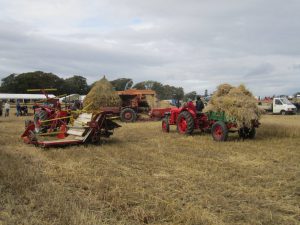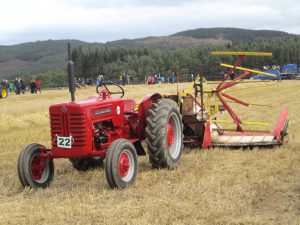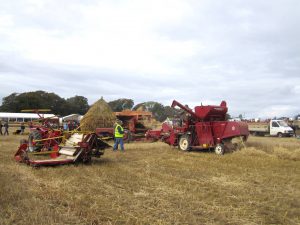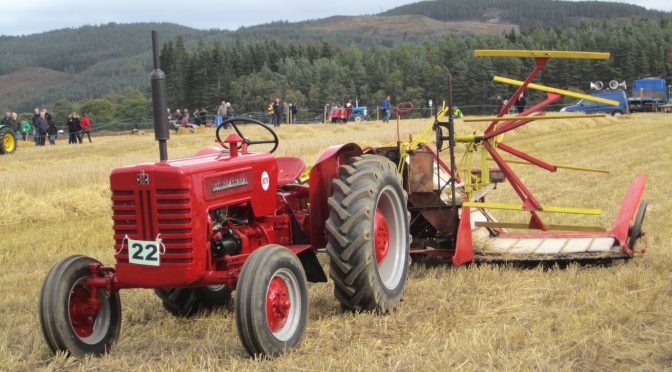 In the early 1950s farmers and agriculturists in Scotland had a choice in the harvesting system they used to cut their grain crops. Over much of the country the grain harvest continued to be cut with the binder which had come into Scotland in the 1880s and 1890s and improved. The second and newer system, was the combine harvester, first used by some of the larger and more progressive farmers and agriculturists.
In the early 1950s farmers and agriculturists in Scotland had a choice in the harvesting system they used to cut their grain crops. Over much of the country the grain harvest continued to be cut with the binder which had come into Scotland in the 1880s and 1890s and improved. The second and newer system, was the combine harvester, first used by some of the larger and more progressive farmers and agriculturists.
In 1952 binders continued to be made by four makers in Britain, one of which was Scottish, and world-renowned for their manufacture. J. Bisset & Sons Ltd, Greenback Works, Blairgowrie, Perthshire continued to make a selection of 5ft and 6ft cut machines. They included tractor draught and an engine driven one with a left hand cut, as well as a hydraulically mounted, p-t-o driven one.
 Harrison, McGregor & Guest Ltd, Albion Works, leigh, Lancashire, was another well-known maker of binders, and its “Albion” brand was well-known in the Scottish harvest field. It made a selection of horse and tractor drawn models, all of which had a left hand cut. They could have a 5ft, 6ft or 7ft cut. The horse drawn binder was land wheel driven, and there was also a tractor pulled one which was also driven in this way. The company also made a tractor p-t-o driven binder, available in a range of cuts.
Harrison, McGregor & Guest Ltd, Albion Works, leigh, Lancashire, was another well-known maker of binders, and its “Albion” brand was well-known in the Scottish harvest field. It made a selection of horse and tractor drawn models, all of which had a left hand cut. They could have a 5ft, 6ft or 7ft cut. The horse drawn binder was land wheel driven, and there was also a tractor pulled one which was also driven in this way. The company also made a tractor p-t-o driven binder, available in a range of cuts.
The third maker was also well-known in the Scottish harvest field: International Harvester Company of Great Britain of 259 City Road, London. Unlike Harrison, McGregor & Guest Ltd, it only made tractor driven models. It specialised in machines with a 6ft or 7ft cut.
The fourth maker was H. Leverton & Co. Ltd, of Spalding, Lincolnshire. It sold the “Lanz” oil bath p-t-o-driven binder with 6ft, 7ft or 8ft cuts. It could have a left or right hand cut.
 By comparison to the binders, the making and selling of combine harvesters was being undertaken on an increasing scale. By 1952 there were at least 8 makers, all with addresses in England; a number were American or continental companies. They included Allis-Chalmers Manufacturing Co., Associated Manufacturers’ Co. (London) Ltd (for “Case”), Bolinders Co. Ltd (for “Munktell”), J. Mann & Son Ltd (for “Class”), Marshall Sons & Co. Ltd (for “Grain-Marshall”), Massey Harris Ltd, Sale Tilney (Agricultural) Ltd (for “Minneapolis-Moline”), and M. B. Wild & Co. Ltd (for “Wild Harvest Thresher”). Some were to continue to be important and renowned makers in the next decades and widely used across the Scottish harvest fields.
By comparison to the binders, the making and selling of combine harvesters was being undertaken on an increasing scale. By 1952 there were at least 8 makers, all with addresses in England; a number were American or continental companies. They included Allis-Chalmers Manufacturing Co., Associated Manufacturers’ Co. (London) Ltd (for “Case”), Bolinders Co. Ltd (for “Munktell”), J. Mann & Son Ltd (for “Class”), Marshall Sons & Co. Ltd (for “Grain-Marshall”), Massey Harris Ltd, Sale Tilney (Agricultural) Ltd (for “Minneapolis-Moline”), and M. B. Wild & Co. Ltd (for “Wild Harvest Thresher”). Some were to continue to be important and renowned makers in the next decades and widely used across the Scottish harvest fields.
These companies sold combines which could be self-propelled or tractor drawn and had varying widths of cut (from 6ft to 12ft), means to hold the cut grain (bag or tank) and weight (from 2,975lb to 55 cwt).
The photographs of the binder and International Harvester combine were taken at the Strathnairn Working Vintage Rally & Display, September 2014. (combine and binder later than 1952).
